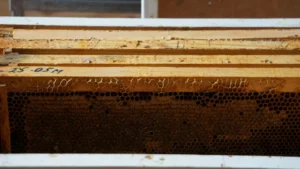Table of Contents
Manuka honey is known for its unique composition and therapeutic properties. However, when subjected to high temperatures for an extended period, the composition of manuka honey, like any other type of honey, undergoes changes. In this article, we will explore what happens to manuka honey when it is heated and how it affects its beneficial compounds.
Composition of Manuka Honey
Before delving into the effects of heating, let’s understand the composition of manuka honey. Regular honey contains sugars, vitamins, hydrogen peroxide, amino acids, proteins, and phytochemicals. Manuka honey, in addition to these components, contains a characteristic compound called methylglyoxal (MGO). Unlike other honey varieties, MGO is not present in the flowers’ nectar collected by bees. Instead, the precursor to MGO, dihydroxyacetone (DHA), is found in varying amounts in the nectar of Leptospermum flowers, from which manuka honey is derived.
Chemicals Used for Authenticity Testing
To determine the authenticity of manuka honey, several chemicals, along with pollen-derived DNA, are used for testing. These chemicals include:
- 3-phenyllactic acid (PLA)
- 2-methoxybenzoic acid (MBA)
- 2′-methoxyacetophenone (MAP)
- 4-hydroxyphenyllactic acid (4HPA)
Other specific compounds found in manuka honey include methyl syringate, leptosperin, pteridine, and lepteridine. Leptosperin has been used for grading and certification purposes, although its thermal stability is not yet well-validated.
Processing of Manuka Honey
The processing of manuka honey involves various steps, including heat treatment and storage. Heat is applied to eliminate pathogens, extend shelf life, and facilitate filtering and pouring. The honey is typically pasteurized for a duration ranging from 30 minutes to several hours, depending on the desired outcomes. Additionally, manuka honey is often stored for an extended period to allow the conversion of DHA to MGO, which enhances its quality and value.
Effects of Heating on Manuka Honey
A recent study conducted by Yoji Kato from the University of Hyogo, Japan, investigated the changes in nine characteristic chemicals of manuka honey during heating. The study used manuka honey classified into four grades based on their MGO levels. The results showed that prolonged heating at 90ºC for up to 2 hours led to a gradual decrease in MGO levels of over 55%. Additionally, there was a significant decrease in 2′-methoxyacetophenone (MAP) content.
The study also revealed that heating caused the vaporization of MAP from the honey, indicating a loss of this compound. The decrease in MAP content depended on the volume of headspace in the vessel used for heating. These findings suggest that heating can potentially reduce the concentration of beneficial and signature molecules in manuka honey.
Implications for Consumers
For consumers who purchase manuka honey with high MGO levels, it is important to note that heating at temperatures of 50˚C or higher can lead to the loss or degradation of MGO. This means that the MGO content of heated manuka honey may be lower than expected. To preserve the antimicrobial properties of manuka honey, it is recommended to opt for raw manuka honey that has undergone sufficient time for DHA to convert to MGO. However, it is essential to ensure that the raw honey is not contaminated with toxins such as tutin.
Alternative Processing Methods
In the future, gamma irradiation could be used to sterilize honey, which would be a more effective method than heating. This method is currently utilized for medical purposes and may also be adopted for table-grade honey. Another promising technique is high-pressure processing at ambient temperature, which has been shown to enhance the quality of honey. A study conducted to measure the antioxidant activity of honey found that high-pressure processing at ambient temperature increased the antioxidant activity by approximately 30% without causing any color changes.
Why is Honey Heated?
Honey is heated for various reasons in commercial applications. It is used in the production of candies, throat lozenges, toothpaste, and drinks. Heating is employed to remove microorganisms, reduce viscosity, and prevent crystallization and fermentation. In cooking, honey is often used as a seasoning in a wide range of recipes. When added to hot teas, the temperature is not typically high enough to cause significant changes in the honey’s composition.
Conclusion
Heating manuka honey can lead to the degradation and loss of its beneficial compounds, including MGO and MAP. Consumers should be aware that the MGO content of heated manuka honey may be lower than expected. Opting for raw manuka honey that has undergone sufficient conversion of DHA to MGO is recommended. Alternative processing methods, such as gamma irradiation and high-pressure processing at ambient temperature, show promise in preserving the quality and beneficial properties of honey.



